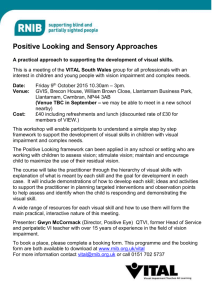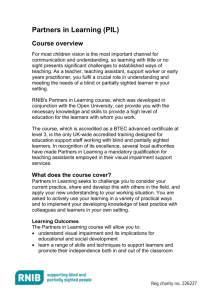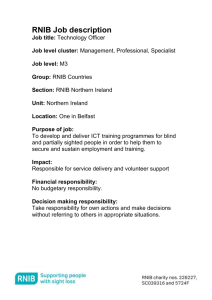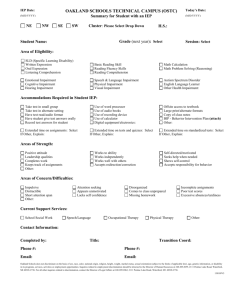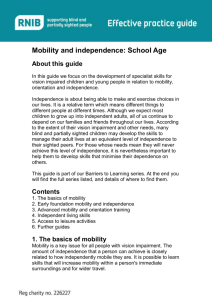VI specialist intervention in special schools
advertisement
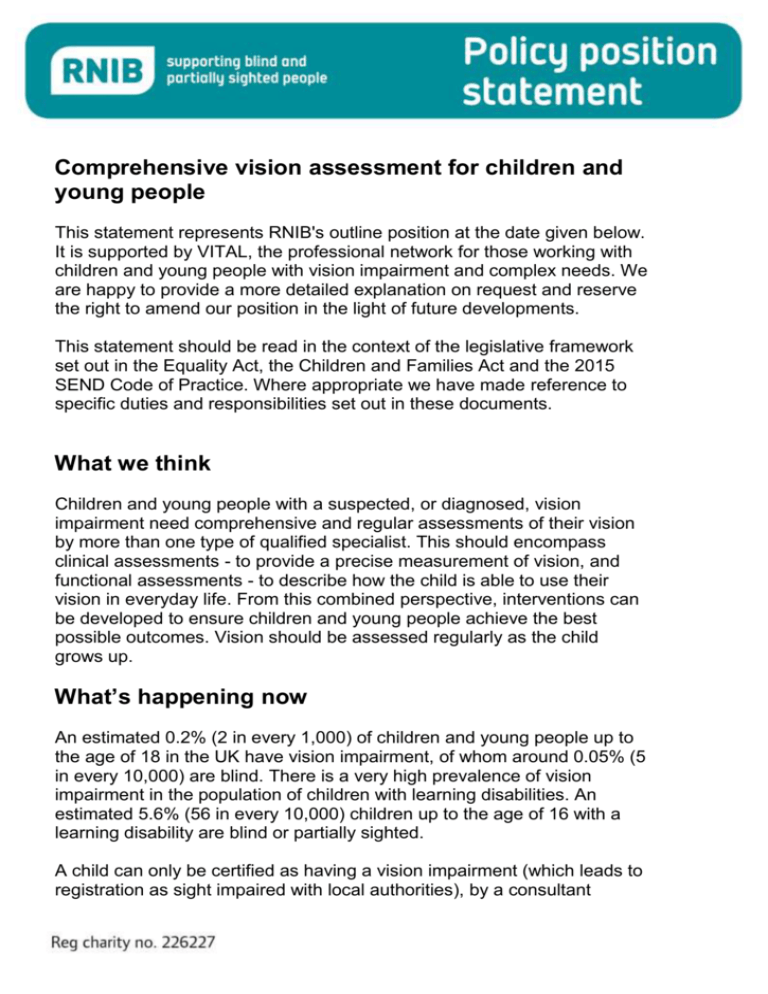
supporting blind and partially sighted people position statement Comprehensive vision assessment for children and young people This statement represents RNIB's outline position at the date given below. It is supported by VITAL, the professional network for those working with children and young people with vision impairment and complex needs. We are happy to provide a more detailed explanation on request and reserve the right to amend our position in the light of future developments. This statement should be read in the context of the legislative framework set out in the Equality Act, the Children and Families Act and the 2015 SEND Code of Practice. Where appropriate we have made reference to specific duties and responsibilities set out in these documents. What we think Children and young people with a suspected, or diagnosed, vision impairment need comprehensive and regular assessments of their vision by more than one type of qualified specialist. This should encompass clinical assessments - to provide a precise measurement of vision, and functional assessments - to describe how the child is able to use their vision in everyday life. From this combined perspective, interventions can be developed to ensure children and young people achieve the best possible outcomes. Vision should be assessed regularly as the child grows up. What’s happening now An estimated 0.2% (2 in every 1,000) of children and young people up to the age of 18 in the UK have vision impairment, of whom around 0.05% (5 in every 10,000) are blind. There is a very high prevalence of vision impairment in the population of children with learning disabilities. An estimated 5.6% (56 in every 10,000) children up to the age of 16 with a learning disability are blind or partially sighted. A child can only be certified as having a vision impairment (which leads to registration as sight impaired with local authorities), by a consultant ered charity number 226227 ophthalmologist following a sequence of clinical vision testing. The tests for registration assess visual acuity and visual field. A full clinical vision test will also check binocular function (how well the eyes work together as a pair); whether there is a squint (strabismus), or lazy eye (ambylopia); refractive error problems; the ocular motility status (eye movements); the health of the inner and outer eye; the internal structures of the eye e.g. the retina, optic nerve, or lens; intraocular pressure; whether there is nystagmus (involuntary movement of the eyes), contrast sensitivity, colour vision and any unusual head posture or visual behaviours. Clinical vision testing gives an accurate and quantifiable measurement of visual ability which can guide treatment where precision is required. Results may indicate treatment with glasses or contact lenses, patching (occlusion), and/or surgery. This precision and numerical scoring enables reliable monitoring of change in the child’s vision over time. Clinical vision testing, however, does not fully assess the nature of a child’s vision. This is due to the rigidity of the tests, the necessity of performing the tests in an unfamiliar clinical setting*, with fixed levels of lighting, and where the child is required to be able to communicate about visual prompts and questions, particularly if they have significant learning or communication difficulties. In addition some children's vision is affected by cerebral vision impairment (CVI), attention, epilepsy and other factors. Clinical vision assessment also does not identify the ways in which a child uses their vision, and this is important to ensure that a child makes the most of whatever sight they have. To supplement clinical findings, we believe that a functional vision assessment should be carried out by a QTVI or QTMSI (qualified teacher of children with vision impairment or multi-sensory impairment). While many local authorities provide good levels of support for this, there are not clear referral pathways from health to education in all areas. What should happen We believe that both clinical testing and functional vision assessments are necessary for comprehensive assessment of what a child can see. To achieve this, the following should happen: rnib.org.uk Babies, children and young people with vision impairment should be referred as soon as possible after identification to the Local Authority VI or sensory education advisory service for support from a QTVI/QTMSI. The QTVI/QTMSI should observe how the child uses their vision across everyday situations and environments, and suggest ways this can be improved, either through the development of strategies or changes to the environment. The QTVI/QTMSI should investigate a wide range of visual skills including: visual awareness; fixation; eye contact; tracking and visually switching from one stimulus to another; visual pursuit; visual field; visually directed reach and hand-eye co-ordination; contrast sensitivity – ability to see low-contrast objects and images; figure-ground discrimination – seeing objects against complex backgrounds; recognition – of objects, faces, pictures, symbols, shapes, colours; perception of depth/3D; mobility and orientation; the effect of environmental factors – lighting, glare, contrast, visual crowding, and extraneous noise. The QTVI/QTMSI should also consider strategies to support CVI (cerebral visual impairment). The QTVI/QTMSI should consult with those who know the child well, e.g. parents, carers, practitioners in undertaking the functional vision assessment. The functional vision assessment of young children or those with complex needs should be an ongoing process as visual skills can change and develop. Children should be seen by the QTVI/QTMSI regularly (depending on their needs), with a focus on the child’s access to education and gaining social and independence skills. For more information please contact the RNIB policy and campaigns team on 020 7391 2123 or campaigns@rnib.org.uk September 2015 * Clinical vision testing would usually take place in a hospital or clinic setting, however, RNIB would recommend practice already occurring in some areas where ophthalmologists and orthoptists conduct clinics within special schools for children with complex needs, supporting the child with a familiar environment and known school staff. rnib.org.uk
